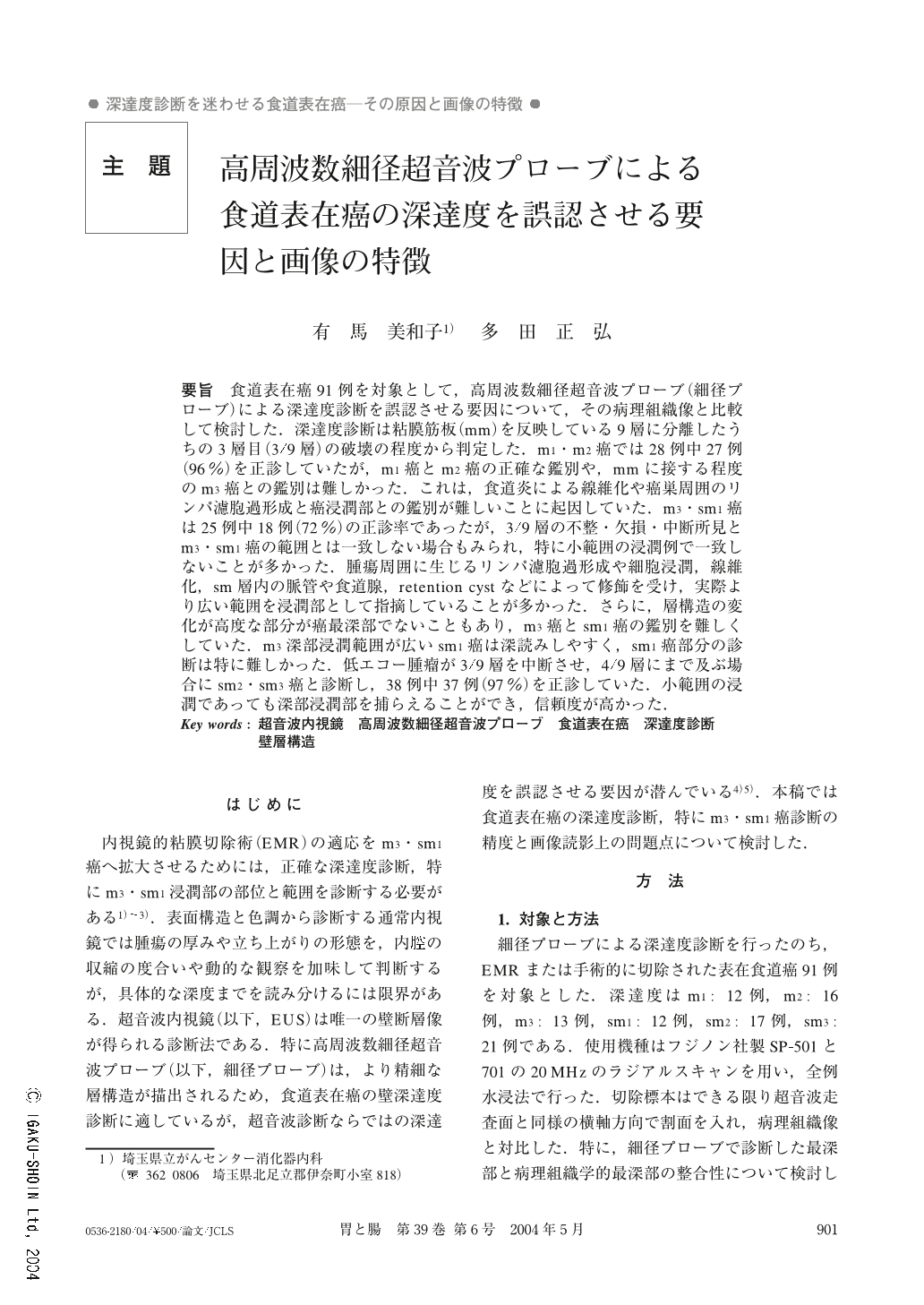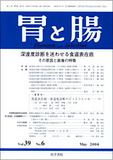Japanese
English
- 有料閲覧
- Abstract 文献概要
- 1ページ目 Look Inside
- 参考文献 Reference
- サイト内被引用 Cited by
要旨 食道表在癌91例を対象として,高周波数細径超音波プローブ(細径プローブ)による深達度診断を誤認させる要因について,その病理組織像と比較して検討した.深達度診断は粘膜筋板(mm)を反映している9層に分離したうちの3層目(3/9層)の破壊の程度から判定した.m1・m2癌では28例中27例(96%)を正診していたが,m1癌とm2癌の正確な鑑別や,mmに接する程度のm3癌との鑑別は難しかった.これは,食道炎による線維化や癌巣周囲のリンパ濾胞過形成と癌浸潤部との鑑別が難しいことに起因していた.m3・sm1癌は25例中18例(72%)の正診率であったが,3/9層の不整・欠損・中断所見とm3・sm1癌の範囲とは一致しない場合もみられ,特に小範囲の浸潤例で一致しないことが多かった.腫瘍周囲に生じるリンパ濾胞過形成や細胞浸潤,線維化,sm層内の脈管や食道腺,retention cystなどによって修飾を受け,実際より広い範囲を浸潤部として指摘していることが多かった.さらに,層構造の変化が高度な部分が癌最深部でないこともあり,m3癌とsm1癌の鑑別を難しくしていた.m3深部浸潤範囲が広いsm1癌は深読みしやすく,sm1癌部分の診断は特に難しかった.低エコー腫瘤が3/9層を中断させ,4/9層にまで及ぶ場合にsm2・sm3癌と診断し,38例中37例(97%)を正診していた.小範囲の浸潤であっても深部浸潤部を捕らえることができ,信頼度が高かった.
Endosonography using a high-frequency miniature US probe (miniature probe) was performed in91 patients with superficial esophageal cancer to evaluate the depth of tumor invasion. The results were compared with the histopathological data and causes of inaccurate analysis were investigated. The point of significance in the sonographic assessment of the depth of invasion is the preservation of the third layer in the nine-layer structure (3/9 layer) obtained by miniature probe endosonography. Correct assessment was made in 27 of 28 patients (96%) with m1・m2 cancers. It was, however, difficult to precisely differentiate between m1 and m2 cancers and to distinguish m3 cancer only just reaching the muscularis mucosae. Fibrous changes due to esophagitis and lymphoid hyperplasia around the tumor cannot be distinguished from the tumor invasion in the sonographic images. In patients with m3・sm1 cancers, the assessment was correct in 18 of 25 patients (72%). In some cases, findings of irregularity or defect, and interruption of the 3/9 layer did not reflect the invasion of m3・sm1 cancers, especially when the range of the invasion was small. Because of the changes in the tissue around the tumor such as hyperplasia of lymph follicles, cellular infiltration and fibrous changes, the growth of the tumor was often estimated to be larger than it really was. The overestimation was also attributable to vessels, esophageal glands and retention cysts, etc. within the submucosal layer. The assessment of sm1 cancer was particularly difficult because, when sm1 cancer spreads largely within the depth of the 3/9 layer, its depth tends to be overestimated. Diagnosis of sm2・sm3 cancer was made when hypoechoic mass interrupted the 3/9 layer and infiltrated the 4/9 layer. The sm2・sm3 cancer assessment was correct in 37 of 38 patients (97%). Even if the range of infiltration was small, the probe showed high reliability in detecting the deep part of tumor invasion.
1) Department of Gastroenterology, Saitama Cancer Center, Saitama, Japan

Copyright © 2004, Igaku-Shoin Ltd. All rights reserved.


